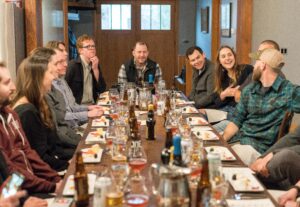Community Matters
 A few years ago, when I was still at UT Austin, I joined several campus deans for an interview over lunch. We were meeting with a candidate for the position of Senior Vice President and Chief Financial Officer. This particular candidate was in an unusual position in that she also knew the person who had previously held the job. She knew he was well respected on campus and took the opportunity to ask this group of senior leaders an interesting question, “What do you appreciate about working with (the former vice president)?” What a great question.
A few years ago, when I was still at UT Austin, I joined several campus deans for an interview over lunch. We were meeting with a candidate for the position of Senior Vice President and Chief Financial Officer. This particular candidate was in an unusual position in that she also knew the person who had previously held the job. She knew he was well respected on campus and took the opportunity to ask this group of senior leaders an interesting question, “What do you appreciate about working with (the former vice president)?” What a great question.
Before I share my answer, you should know that traditionally the student leadership of UT Austin is highly involved, and completely willing to ask any university administrator a tough question. If they didn’t come into office that way, they were well tutored by previous leaders who continued to be highly involved post-graduation.
All this to explain my answer to the question. I said, “What I appreciate most is how willing he is to meet with students, even when they want to challenge him. I’ve known senior leaders, even presidents, who only meet with students when they absolutely have to. If they don’t work with students regularly, they seem to be afraid of them, as if they were wild animals you have to watch carefully because you don’t know what they will do next.”
There was sort of a loaded silence from the room, and I looked around at my colleagues, and smiled as they laughed, “Ok to be fair, students aren’t always predictable, but particularly on this campus, you need to be willing to work with students. And I have always appreciated that (vice president) wasn’t afraid of meeting with a student or with a group of students.” And around the table, the deans agreed with me.
Another version of this anxiety, also from UT Austin, came after the opening of a new Computer Sciences building. It was lovely, with a large, light atrium with tables and chairs all around the open space. It was a marked contrast to the previous old building. The Dean of Students got a call from one of the department chairs after the building had been open for a bit. The Chair was concerned because so many students were gathering in the building. They were studying in groups, having lunch, working on their computers. The Dean asked if they were creating problems, leaving trash around. No, the trash cans were full and some of the furniture had been moved, but they were there all the time.
Their previous building had been old with narrow halls and no place to sit while waiting to meet with a faculty member, let alone hang out. The Chair didn’t actually say it this way, but he and the faculty in his department weren’t used to groups of students simply being around being students. It was disconcerting to the Chair and his colleagues.
I thought of both of these experiences recently when I got a call from a colleague. The OU College of Nursing is in the process of an expansion in our undergraduate program. To handle the increased number of classes, we are now using classrooms in a group of buildings known as University Research Park. Most of the occupants of the buildings in the area are filled with offices for research and development programs. Our students are the only students in these spaces and now that we are in year two of the expansion, there are a lot of students using the food court at lunch time. And someone is disconcerted. I don’t know who or exactly what the concern is since anytime I’ve gone to that food court before now, there was hardly anyone in there. From my perspective, it looks more welcoming with people in the space. I think it’s wonderful seeing students having meals together. It’s community. It’s the entire idea behind a campus-wide committee I sit on named Belonging and Inclusion.
When I worked at UTSA as the university was working to make significant changes in research and in the student experience, people appreciated the efforts to develop a vibrant campus life. I’ll always remember the Libyan-born president of the Faculty Senate telling me as we worked to develop the football program, “I don’t really understand American football, but our students deserve this.” The work of the Student Affairs staff was seen and valued. The importance of bringing students together in community spaces was valued.
Conversely, at UT Austin, people seemed to take the amazing on-campus experience for granted. They acted as if all that was needed was to bring 50,000 bright students together and all would be well. While there is some truth to that idea, the reality is that campuses need processes, procedures, and guidelines and student leaders need coaching and chances to learn as part of the experience.
Campuses need administrators, staff and faculty to be involved with students in support of their campus experiences. Campuses need to create spaces for students to gather. They need a way to purchase food, tables and chairs and these days spaces also need electrical outlets. Outdoor spaces need benches and picnic tables. Administrators who see students as a concern don’t look for such items or they see them as expensive amenities rather than necessities. I’ve been lucky in my career to work with business affairs colleagues who were at least open to these ideas and many who supported them when we made our case.
While my examples are about students, the same is true for the members of any organization. So no matter your role or the type of organization, have you wandered around lately to see where people are gathering and to notice whether they are there because of the design of the space or in spite of it? If not, maybe it’s worth a walk around. Maybe it’s worth sitting in one of those spaces to see how it feels. And if you have one of those colleagues who’s a bit suspicious about a gathering of students perhaps you could take them along. It’s worth a try and it’s always good to get out and about and see what’s going on.
Take care,
Gage
